Fast Forward for Future Factories
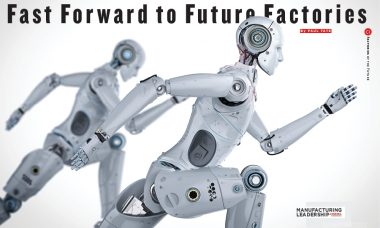
The COVID pandemic has triggered a surge in M4.0 adoption across almost every function of manufacturing production that promises to rapidly transform the way factories are designed, operated, and managed in the next decade, reveals the MLC’s latest Factories of the Future survey. By Paul Tate

Every journey of digital transformation takes time. Manufacturers must wrestle with, and overcome, a multitude of technical, cultural, management, organizational, and partnership issues to swiftly and effectively reach their ultimate digital goals.
Then something happens that suddenly makes rapid progress more urgent than ever. A global event that forces leadership teams to respond by hitting the fast forward button on their strategic plans. The impact of the continuing COVID pandemic on manufacturing is proving to be exactly that kind of catalyst.
The results of the Manufacturing Leadership Council’s 2021 survey on Factories of the Future clearly show that, over the last year, the impact of the pandemic has forced a broad range of industrial companies to make fundamental and rapid changes across their manufacturing value chains. And the implications for the future of the industry are only just beginning to be understood. The fallout from the pandemic is already spurring more and more manufacturing companies to accelerate their digital progress and change the way that factories will be designed and operated in the future.
M4.0 Inflection Point
When the MLC first surveyed its membership to understand more about the pandemic’s potential impact on M4.0 adoption during the height of the first COVID wave in April and May of last year, just over 50% of respondents indicated that it had prompted them to accelerate their adoption of M4.0 technologies across their organizations and factory floors. At that time, it was not clear if that initial response was simply driven by the urgent need for immediate mitigation tactics to cope with the sudden disruption.
The MLC’s latest research, however, clearly indicates that this acceleration surge was far from a temporary fix. Over 40% of respondents in our latest survey now confirm that they will continue to accelerate their rate of M4.0 adoption for the foreseeable future (Chart 1). For two in five manufacturers, this marks an inflection point in M4.0 adoption that is set to drive digital transformation faster than ever before.
A further third, the same proportion as in the initial survey, also confirm that they will continue with their M4.0 adoption plans at the same rate as before the pandemic, despite widespread disruption to their businesses over the last few months.
Nevertheless, some companies have also seen revenues dive during that period, forcing a reduction in budgets across multiple areas of the company, including their M4.0 plans. Today, around one in five say they have been forced to decelerate their M4.0 adoption plans accordingly, at least for the time being. As economic and business recovery progresses, however, especially with the new hope of mass immunity provided by COVID-19 vaccines, those strategic digitization plans may yet be reengaged.
Permanent Health Changes
Accelerated digitization is not the only lasting impact of the COVID pandemic for manufacturers. Over the last year companies have radically revamped their plant floor health and safety procedures to protect their workers and create a safe and reassuring environment for their employees. From redesigning frontline workstation layouts and activities to allow adequate social distancing, to temperature testing on entry, multiple sanitation stations across the plant, obligatory protective clothing, staggered shifts, and remote working options, manufacturers have responded with a multitude of new safety measures in their facilities. [/et_pb_text]
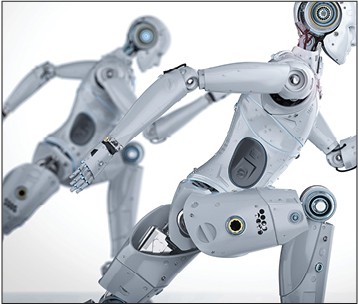 “The fallout from the pandemic is already spurring more and more manufacturing companies to accelerate their digital progress and change the way that factories will be designed and operated in the future.”
“The fallout from the pandemic is already spurring more and more manufacturing companies to accelerate their digital progress and change the way that factories will be designed and operated in the future.”
Yet looking ahead, a massive 80% of respondents in the latest survey say that they intend to continue with some of these new plant floor health and safety measures, not just for the duration of the pandemic, but permanently (Chart 2). Seven percent of respondents even suggest they intend to continue with all of their health and safety changes for the future. Clearly, some aspects of the traditional manufacturing workplace seem to have changed forever as a result of the COVID crisis.
Diverse M4.0 Maturity Levels
As some manufacturers begin to accelerate their M4.0 adoption and others continue with their established digitization plans, the M4.0 maturity levels across the industry remain patchy. Most consider their current maturity level in the middle range, predominantly between five and seven on a scale of ten, where ten is the highest maturity level (Chart 3). A quarter, however, feel that they are still in the early stages of digitization, scoring themselves at a low two (9%) or three (16%) on the maturity scale. It will be interesting to track changes in these results in future MLC surveys to better understand rates of progress in the months to come.
Nevertheless, for those that have grasped the digital challenge, an encouraging 26% say that they have now scaled their M4.0 efforts on a company-wide basis (Chart 4), more than double the result of two years ago when the figure was 12%. What’s more, a further 18% are now implementing M4.0 on a single project basis, again double the figure from 2019. Meanwhile, a further 19% say they have already begun experimenting with a range of small scale M4.0 pilot projects, often the forerunner of wider corporate adoption, so further widespread implementations are likely to follow in these companies too, over the next 12 months.
These strong indications of increasing rates of M4.0 adoption and maturity are also reflected in a breakdown of which functions are involved. Over the last year there has been a marked shift in M4.0 implementation levels across almost every function in the survey as many companies have moved from what they considered to be early-stage adoption last year, to the more mature intermediate level in 2021 (Chart 5). This shift is most notable in the areas of production and assembly, quality operations, procurement, distribution, and customer support.
Nevertheless, there is clearly still a great deal of headroom for improvement as only a minority of companies in each category so far consider their levels of adoption to have reached an advanced stage. 
“Digital twins currently top the list of the top ten technologies that companies feel will be most important to them in the near future.”
Top M4.0 Technologies
Such improvements will be facilitated by the further implementation of a combination of key M4.0 technologies, and future manufacturing investment plans show these are predominantly focused around more visual, predictive, collaborative, and augmented digital tools (Chart 6).
Ranked by levels of investment intent for the next two years, the latest survey reveals that digital twins currently top the list of the top ten technologies that companies feel will be most important to them in the near future, with over a third of companies (34%) planning to expand their use of digital twins over the next 24 months.
Initially conceived to help streamline the product design process in more visual ways, digital twin technologies have begun to sweep across organizations as an effective tool to virtualize almost every aspect of the organization, from production processes, to plant floor design, workflows, supply chains, material and waste flows, and distribution networks, increasingly supported by real-time IoT data (26%), predictive analytics (23%), and AI (29%).
The ability to share these virtual models in a collaborative way across multiple functions and partners is also driving the popularity of widely connected digital threads across the organization, with 28% of companies planning to invest more extensively in the future.
Tools that help augment the workforce are also high on the investment list, including AR and VR systems (29%) allowing the remote sharing of visual data and helping train employees, and collaborative robots (29%) that can help augment a multitude of physical tasks in a safe and effective way on plant floors and beyond.
Lag in Managing Change
While M4.0 technology adoption seems to be moving swiftly, however, many companies, are still not up to speed when it comes to the associated change management processes needed to support their digital transformation (Chart 7). Almost half the companies in the survey (47%) admit that they are still defining their change management processes and training programs associated with M4.0 plant floor initiatives. Another quarter (26%) have yet to even consider developing a change management approach, although they do say they plan to do so at some stage.
This lag in the development of change management processes may become increasingly critical to both the pace and success of M4.0 adoption in the years ahead, and leadership teams clearly need to take this aspect more seriously if they wish to bring their workforce along with them to reach their digital goals.
Hybrid Future Factory Models
At a more strategic level, the survey also reveals that there are some significant trends underway in how manufacturing companies plan to structure and manage their increasingly digitally enabled factories in the future too.
The days when companies built, and depended on, large consolidated global factories alone seem to be numbered. Perhaps intensified by the lessons of the pandemic and a rising awareness of the vulnerabilities and complexities of global mega-factory footprints in a disruptive world, the last year has seen an accelerated shift away from large factories, or networks of large factories, as a future production strategy – down from 35% in 2020 to just 23% this year (Chart 8).
The majority of companies now envisage their future factory strategy to be a hybrid mix of smaller, local production sites and large facilities (48%), or simply a network of more flexible smaller factories that operate closer and more responsively to the local markets they serve (27%).

“The lag in the development of change management processes may become increasingly critical to both the pace and success of M4.0 adoption in the years ahead.”
“And those smaller factory networks will be increasingly digitized, the results reveal. Three quarters of respondents (74%) expect their future factory models to operate as a hybrid of humans and digital technologies, including robotics, additive and subtractive production systems, and increasingly digital processes (Chart 9).
And while very few expect digital technologies to entirely automate future factories to become totally lights out, autonomous operations (3%), nine out of ten respondents either partially agree (74%) or fully agree (17%) that tomorrow’s factories will indeed evolve to be increasingly self-learning facilities, harnessing the power of technologies such as AI and machine learning (Chart 10).
A More Collaborative Future
The increasing use of advanced analytical and predictive self-learning technologies, digital twins and threads, and ever more virtual and visual tools in tomorrow’s factories makes one thing very clear, however. The way those factories will be managed will be more collaborative than ever before.
Within the next two years, half the respondents (50%) expect their factories to be managed in a more collaborative way, with a greater emphasis on involving employees, customers, and suppliers in production processes (Chart 11). That is a significant and rapid increase in collaborative management approaches from the current level of just 18% today. Traditional, highly centralized management structures are already few and far between at 6%, and look set to reduce even further to only 4% in the same period. Even today’s prevalent decentralized approaches, where corporate and plant management structures are in a hybrid form, are predicted to almost halve from 63% to 34% over the next 24 months.
Preparing for Cyber Disruption
As digitization increases, of course, so do the potential levels of vulnerability of plant floor systems and assets to malicious cyberattack. Many companies have already begun to address the issue (Chart 12) and now consider themselves to be either totally secure (26%), or partially secure (53%) from cyber disruption. Nevertheless, almost one in five say they remain either partially vulnerable (13%) or highly vulnerable (4%). Obviously, there is still work to be done in some companies to improve their plant floor cyber protection strategies.

“As digitization increases, so do the potential levels of vulnerability of plant floor systems and assets to malicious cyberattack.”
Raising workforce awareness about potential cyber threats is an essential part of that protection process. Reassuringly, survey respondents reveal that two thirds of companies now have some level of workforce preparedness program either in place or underway (Chart 13).
Fourteen percent say they already have extensive plans and employee training in place and routinely conduct simulations; 40% say they now have some form of plan and cyber awareness training available; and another 18% are now actively planning to develop those cyber training programs in the near future. Again, though, that leaves a gap of 17% of companies that have yet to catch up with the realities of potential plant floor cyber threats, and work remains to be done.
Digitization Challenges Remain
Some aspects of manufacturing’s digitization journey continue to hinder progress, however. Once again, this year, the challenges of upgrading legacy equipment (48%), the lack of skilled employees (47%), and access to adequate investment budgets (46%), continue to dominate the list of key obstacles that manufacturers face as they strive to adopt new digital technologies in their production operations (Chart 14). Even organizational structures and cultures that resist change are still an issue for almost a third of companies (31%).
While legacy systems issues and skill shortages are not easy to fix through internal changes alone, leadership teams can have a direct impact on unblocking other obstacles to progress, such as access to investment budgets and improvements to organizational structures and cultures. It is hoped that the growing awareness of the opportunity impact of digital transformation among leadership teams will make an increasingly important difference to creating a positive climate of change in many manufacturing organizations in the years ahead.
M4.0’s Competitive Imperative
And if those leadership teams need any further evidence of the potential benefits that digital transformation can bring to help motivate them, the survey clearly indicates that a majority of survey respondents (57%) at least, believe M4.0 has the powerful ability to help manufacturing companies create a unique competitive advantage for their businesses in the future (Chart 15). What’s more, half the respondents think M4.0 represents a clear game changer for the entire manufacturing industry in the years ahead (Chart 16).
With those issues at stake, and the lessons of the COVID pandemic as a compelling spur to action, pushing the fast forward button to create increasingly digitally enabled factories of the future is becoming a more important competitive imperative than ever for the decade to come. M
Part 1: COVID-19 Impact
1 41% of Manufacturers Will Continue to Accelerate M4.0 Adoption
Q:What effect has the COVID-19 pandemic had on your company’s adoption of M4.0 in its plants or factories?
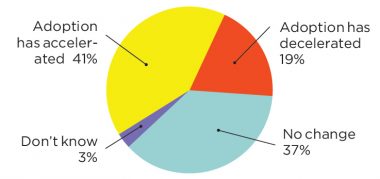
2 80% Say Some COVID-19 Health & Safety Changes Will Be Permanent
Q: Do you expect any additional plant floor health and safety measures and procedures you have introduced as a result of the COVID-19 pandemic to continue into the future?
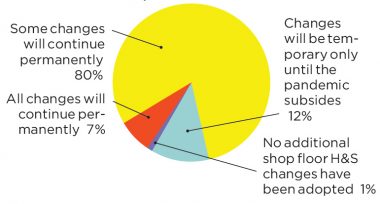
Part 2: Status of M4.0 Adoption
3 Today’s M.40 Factory Maturity Levels Predominantly Mid-Range
Q: How would you assess the Manufacturing 4.0 maturity level of your company’s factories or plants?
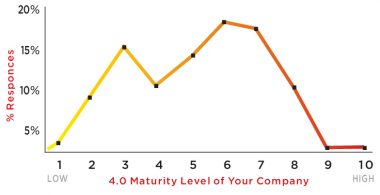
4 A Quarter Already Implementing M4.0 Company-Wide: Another Third Have M4.0 Pilots or Projects Underway
Q: Which activity best describes the primary focus of your company’s M4.0 efforts today?
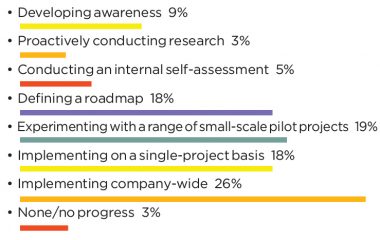
5 Levels of M4.0 Adoption Have Increased Across Almost All Functions in the Last Year (2020 vs 2021)
Q: At what stage of M4.0 adoption are the following functions in your company?
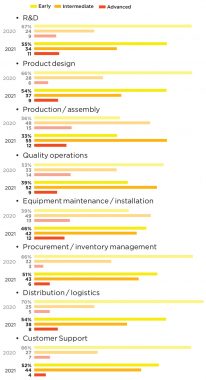
6 Top 10 Technology Investment Priorities for the Next 2 Years
Q: Where does your company stand regarding the following technologies?

7 Almost Half of Companies Still Defining M4.0 Change Management Processes
Q: At what stage is your organization with a change management program associated with M4.0 plant floor initiatives?
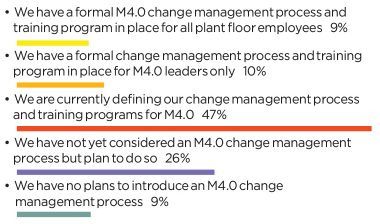
Part 3: Factory Organization & Management
8 Shift Accelerates Towards Small or Hybrid Factory Networks (2020 vs 2021)
Q: Looking ahead, which statement most closely describes what your company’s future factory strategy will be?
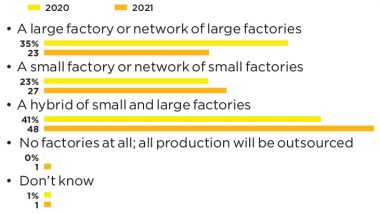
9 Three Quarters Expect Human/Digital Factory Model
Q: What is the expected future state of your factory model?
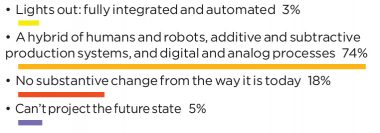
10 Over 90% Foresee Some Degree of Self-Learning in Tomorrow’s Factories
Q: Thinking about the impact of technologies such as AI and machine learning, to what extent would you agree or disagree with the following statement: “Tomorrow’s factory will evolve to be a self-learning facility.”
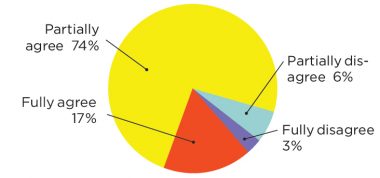
11 Collaborative Management Approaches Set to Dominate Within 2 Years
Q: How would you characterize how your factories/plants are managed today and what do you anticipate will be the primary way they will be managed in the next 2 years?
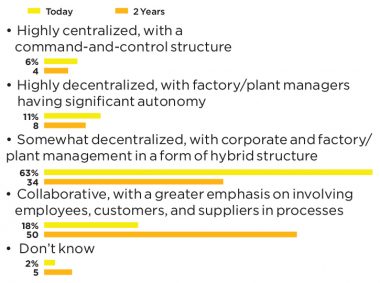
Part 4: Cybersecurity Readiness
12 Cybersecurity Levels Still Leave
Room for Improvement
Q: As factories become increasingly networked and digitized, how would you rank your company’s technical security level against potential cyberattack/disruption to plant floor systems and assets?
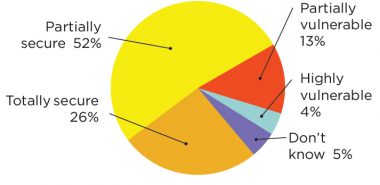
13 Two Thirds Are Preparing Their Workforce for Cyber Attacks
Q:What is your level of workforce preparedness in the event of a cyberattack/disruption to plant floor systems and assets?
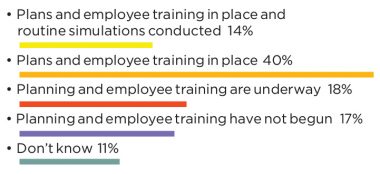
14 Legacy Systems, Skills, and Budgets Remain Biggest Obstacles to M4.0 Adoption
Q: What do you feel are your company’s primary roadblocks to implementing your M4.0 strategy?
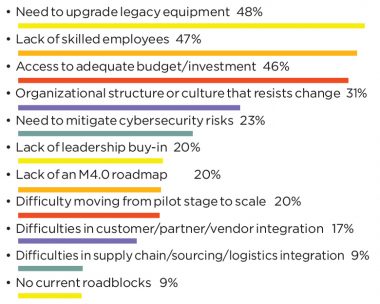
15 57% Believe M4.0 Creates a Unique Competitive Advantage
Q: Do you believe that the adoption of M4.0 creates a unique competitive advantage for your company or is it merely table stakes to remain in the game?
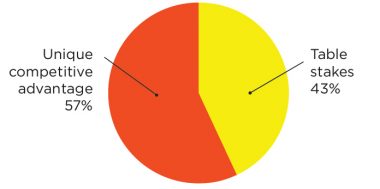
16 Half Also Believe M4.0 is a True Game Changer for Manufacturing
Q: Ultimately, how significant an impact will M4.0 have on the manufacturing industry?
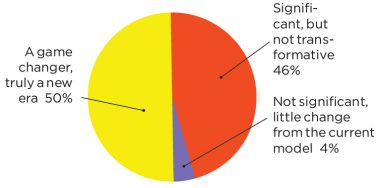
Survey development was led by Paul Tate, with input from the MLC editorial team and the MLC’s Board of Governors.